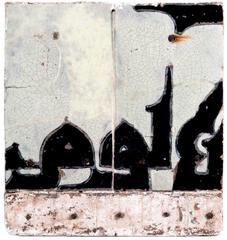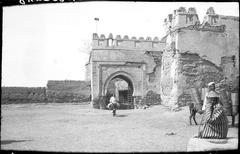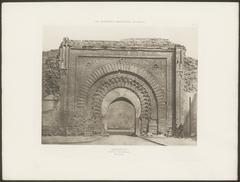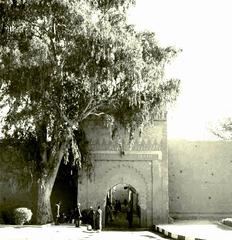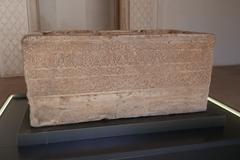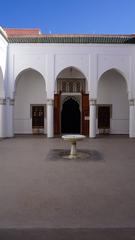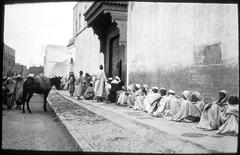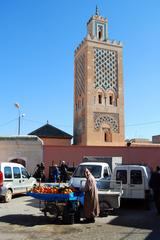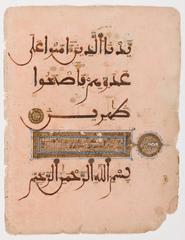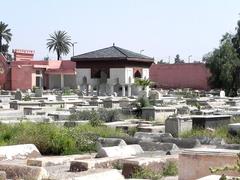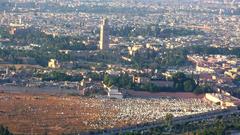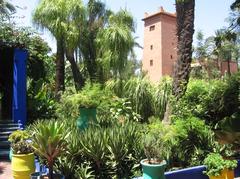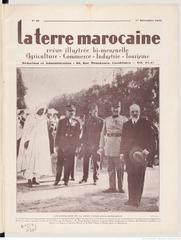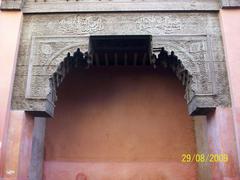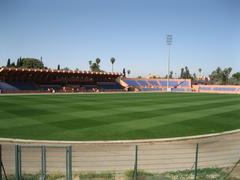Royal Theatre Marrakesh: Visiting Hours, Tickets, and Historical Sites Guide
Date: 03/07/2025
Introduction to the Royal Theatre Marrakesh
The Royal Theatre of Marrakesh (Théâtre Royal de Marrakech) is a defining cultural landmark that seamlessly unites Morocco’s historic heritage with modern architectural innovation. Located in the energetic Gueliz district, the theatre has evolved from a visionary project in the 1970s to a dynamic arts hub since its official inauguration in 2001 under the patronage of King Mohammed VI (Dar Zaman). Designed by architect Charles Boccara, it stands out for its fusion of traditional Moroccan craftsmanship—such as intricate zellige tilework and moucharabieh screens—with European classical influences, including grand marble columns and a prominent cupola (Salles.ma; Gidza).
Today, the Royal Theatre is a vibrant venue hosting classical concerts, operas, Moroccan music festivals, and international events like the Marrakech International Film Festival (Marrakesh Desert Tour; Maroc Marrakech). Its 1,200-seat open-air amphitheatre and ongoing plans for an 800-seat opera house create a unique environment for experiencing Morocco’s thriving arts scene in an unforgettable setting (Dar Zaman).
With convenient access opposite the Marrakech Train Station and proximity to cultural highlights like Jardin Majorelle and the historic medina, the theatre is easily reached and perfectly situated for exploration (Lonely Planet; Trip.com). This comprehensive guide details the theatre’s history, architecture, visitor tips, and cultural significance to help you plan a memorable visit.
Table of Contents
- Introduction to the Royal Theatre Marrakesh
- Origins and Historical Development
- Architectural Highlights
- Practical Visitor Information
- Architectural Significance in Marrakesh’s Urban Landscape
- Frequently Asked Questions (FAQ)
- Plan Your Visit and Stay Connected
- Visual Media
- Summary and Visitor Recommendations
- References and Further Reading
Origins and Historical Development
The Royal Theatre’s inception was part of Morocco’s broader push to modernize urban centers and elevate the national arts scene. Conceived in the 1970s and designed by Charles Boccara, the project faced decades of delays before its grand opening in September 2001 (Dar Zaman; Safarway; Gidza). Initially, only the exterior, main reception, and the 1,200-seat amphitheatre were completed, with the opera house section remaining unfinished as of 2025. The theatre is strategically located at Avenue Hassan II and Boulevard Mohammed VI, directly across from the Marrakech Train Station, anchoring the Gueliz district as a new cultural epicenter (Lonely Planet; TouchScreenTravels).
Architectural Highlights
Exterior Design and Influences
Charles Boccara’s architectural vision merges Moroccan traditions with Roman and classical European elements. The grand marble columns and the imposing cupola dominate the façade, while Moroccan touches—zellige tilework, horseshoe arches, and moucharabieh screens—bring authenticity and local flair (Dar Zaman; Salles.ma; Maroc Marrakech). The dome, visible from afar, echoes both Islamic and Mediterranean architectural traditions, making the theatre a recognizable city landmark (Gidza).
Interior Spaces
Inside, visitors are welcomed by a spacious reception hall often used for art exhibitions. The open-air amphitheatre, inspired by ancient Roman venues, offers tiered seating for approximately 1,200 guests (Lonely Planet). Moroccan craftsmanship is on full display, with ornate arches, colorful mosaics, and carved woodwork, complemented by modern lighting and acoustics (Salles.ma). While the opera house remains incomplete, the theatre’s existing spaces host a wide variety of performances, exhibitions, and community events (Maroc Marrakech).
Notable Features
- Dome and Cupola: Architectural centerpiece merging Moroccan and Mediterranean styles (Dar Zaman).
- Traditional Tilework: Zellige mosaics highlight Morocco’s artisanal heritage (Salles.ma).
- Grand Arches and Columns: Evoke a blend of Roman and Moorish influences (Gidza).
- Open-Air Amphitheatre: Designed for natural ventilation and dramatic performances, though acoustics may vary (Dar Zaman).
Ongoing Development
There are ongoing plans to finish the opera house and upgrade facilities, ensuring the Royal Theatre remains at the forefront of Marrakesh’s cultural renaissance (Dar Zaman).
Practical Visitor Information
Visiting Hours
The Royal Theatre’s opening is typically tied to scheduled performances, exhibitions, or guided tours. Standard visiting hours are from 10:00 AM to 8:00 PM on event days, but schedules may vary. Always check the official website or call ahead for current details.
Tickets and Ticketing Tips
Tickets are available at the box office and online through the theatre’s official website or authorized platforms. Prices range based on the event: expect to pay more for international productions and major festivals. Student, senior, and resident discounts may be available—ask at the box office. For high-demand events, such as the Marrakech International Film Festival, booking well in advance is advised (Trip.com).
Accessibility
The Royal Theatre is equipped with wheelchair access, reserved seating, and accessible restrooms. Contact the venue ahead of your visit if you require specific accommodations, as some areas of the historic structure may present challenges (Salles.ma).
Directions and Travel Advice
Situated opposite the Marrakech Train Station in Gueliz, the theatre is easy to reach by train, taxi, or city bus. Taxis are plentiful but be sure to negotiate fares in advance (Along Dusty Roads). If driving, be aware that parking is limited during major events.
Nearby Attractions
Enhance your visit by exploring nearby cultural sites such as Jardin Majorelle, Jemaa el-Fnaa, the Koutoubia Mosque, and the historic medina. The Gueliz district also offers a variety of dining and shopping options.
Guided Tours and Photography
Guided tours are occasionally available, particularly during off-performance hours. These tours provide insight into the theatre’s history and architecture. Photography is permitted in public spaces but restricted during performances—confirm on site.
Architectural Significance in Marrakesh’s Urban Landscape
The Royal Theatre is both a symbol of Marrakesh’s modern aspirations and a bridge to its storied past. Its blending of Moroccan and European styles exemplifies the city’s identity as a crossroads of cultures and ideas (Salles.ma; Evendo), while its prominent location enhances its role as a city landmark.
Frequently Asked Questions (FAQ)
Q: What are the theatre’s visiting hours?
A: Generally from 10:00 AM to 8:00 PM on event days; check the official schedule for updates.
Q: How do I buy tickets?
A: Tickets are available at the box office and online. Early booking is recommended for popular events.
Q: Is the theatre wheelchair accessible?
A: Yes, with accessible entrances and seating. Contact the venue for specific needs.
Q: Are guided tours available?
A: Occasionally, by advance arrangement. Inquire at the box office or by phone.
Q: What attractions are nearby?
A: Jardin Majorelle, Jemaa el-Fnaa, Koutoubia Mosque, Gueliz shopping, and the medina.
Q: Is there a dress code?
A: Smart-casual and modest dress is recommended.
Q: What languages are spoken?
A: Arabic and French are predominant; some staff speak English. Program notes are often available in English.
Plan Your Visit and Stay Connected
The Royal Theatre of Marrakesh is more than a historical building—it is a living center of Moroccan arts and culture. For event schedules, ticketing, and latest updates, visit the official theatre website. Download the Audiala app for real-time visitor tips, and follow the theatre on social media for news, virtual tours, and exclusive content.
Visual Media
- Exterior Image: “Royal Theatre Marrakesh exterior with marble columns and dome”
- Interior Image: “Open-air amphitheatre seating at the Royal Theatre Marrakesh”
- Interactive Map: View the theatre’s location relative to the Marrakech Train Station and nearby attractions.
- Virtual Tour: Check the official website for available virtual tours of the theatre’s interior.
Summary and Visitor Recommendations
The Royal Theatre of Marrakesh is a must-visit for anyone interested in architecture, culture, or the performing arts. Its iconic design, diverse programming, and central location make it a highlight of any Marrakesh itinerary. Plan ahead by booking tickets in advance, checking event schedules, and considering guided tours for a deeper appreciation of this remarkable venue. Explore nearby attractions to round out your cultural journey in Marrakesh.
References and Further Reading
- Dar Zaman
- Marrakesh Desert Tour
- Along Dusty Roads
- Trip.com
- Salles.ma
- Gidza
- Maroc Marrakech
- Lonely Planet
- Evendo
- Official Royal Theatre Website
